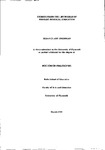STORIES FROM THE LIFEWORLD OF PRIMARY PHYSICAL EDUCATION
| dc.contributor.author | SHORMAN, SUSAN CLARE | |
| dc.contributor.other | Plymouth Institute of Education | en_US |
| dc.date.accessioned | 2013-09-18T13:04:34Z | |
| dc.date.available | 2013-09-18T13:04:34Z | |
| dc.date.issued | 1999 | |
| dc.identifier | NOT AVAILABLE | en_US |
| dc.identifier.uri | http://hdl.handle.net/10026.1/1863 | |
| dc.description.abstract |
This thesis attempts to Hnk conceptual analysis with empirical data and shows the interplay between the two. The first part of the thesis considers the work of Whitehead who presents an alternative philosophical framework to re-conceptualise our understanding of the value of Physical Education (PE). She uses the classical philosophical debate about the body and the mind to encourage us to view PE for its own intrinsic worth which she argues, may contribute to the quality of life or well-being of the individual. The dualist and monist theories of the body/mind split are considered and a phenomenological framework for understanding these theories is presented. The notion of the person as an integrated whole is developed as a possible way to re-conceptualise a framework for PE within the primary curriculum. The research methods are developed from the previous debates and use a phenomenological framework to arrive at a final case study where one teacher and her class of 27 Year One/Two children (aged five to six years) were asked to tell their story about PE. Key themes which arose from the data were: PE is different from all the other activities which take place in school. The children experience problems whilst changing for PE. The children direct little attention towards the physical skills in PE. PE can cause the children to experience discomfort. There is a temporal dimension to the PE experience. The children talked about PE requiring them to think. There was a strong imperative dimension to PE although the teacher structured elements of choice and problem solving within the lesson. The children highlighted appropriate behaviour as important. Lastly there was a dominant focus on the emotional dimension of the experience. This study highlights the need to continue and extend the debate within PE: i) to be more creative in the presentation of the PE experience for children by using language which is embodied rather than disembodied; ii) to listen to the stories from children about their experiences in PE to gain a greater understanding of how children receive the PE experience; and iii) to consider how this experience can contribute towards the well-being of the children. | en_US |
| dc.language.iso | en | en_US |
| dc.publisher | University of Plymouth | en_US |
| dc.title | STORIES FROM THE LIFEWORLD OF PRIMARY PHYSICAL EDUCATION | en_US |
| dc.type | Thesis | |
| plymouth.version | Full version | en_US |
| dc.identifier.doi | http://dx.doi.org/10.24382/4444 | |
| dc.identifier.doi | http://dx.doi.org/10.24382/4444 |
Files in this item
This item appears in the following Collection(s)
-
01 Research Theses Main Collection
Research Theses Main


